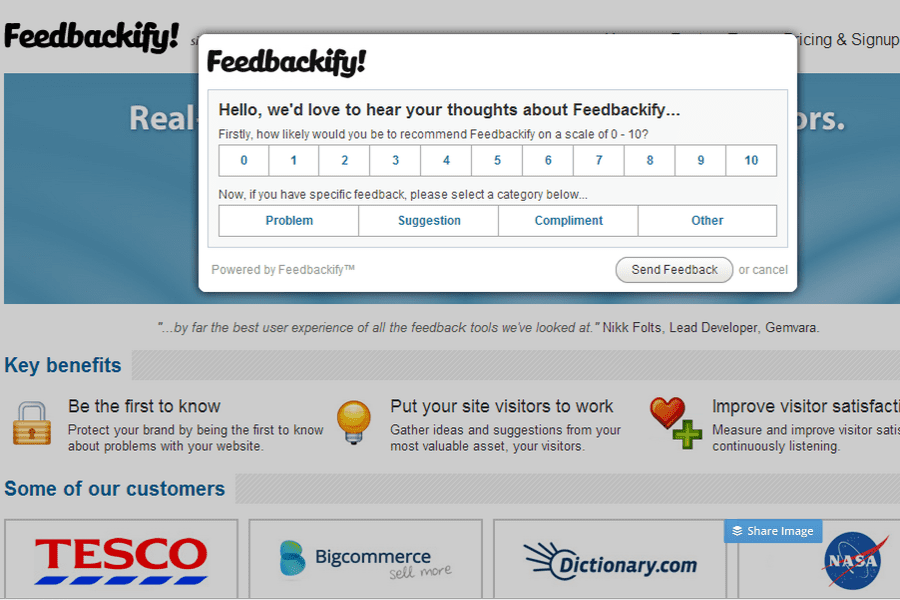What Is Customer Feedback? +Benefits, Methods, Tools
- Published:
- Updated: July 3, 2024


Whether building a new product or optimizing an existing one, gathering product feedback is crucial for creating a product or service that resonates with your target audience and users.
Considering user opinions, ideas, and criticism helps develop a product strategy and roadmap that contributes to product-led company growth and better customer experiences. Implementing feedback into your product creation process starts with collecting, analyzing, and implementing insights correctly.
Let’s start by looking at customer feedback, its benefits, how to collect it, and the best customer feedback tools.
What Is Customer Feedback?
Customer feedback is information provided by customers about their experience with a product or service. The goal is to understand their level of satisfaction and to help product, customer success, and marketing teams identify areas of opportunity.
The Customer Feedback Loop
A customer feedback loop is a customer experience strategy that aims to improve your product based on customer reviews. This feedback loop is based on the concept of mutual interaction between both a business and its customers. It helps understand what features of your product your customers like or dislike the most, how your product could work better, and what can be added to enhance your customer experience.

Your customer feedback loop can be broken into four stages:
- Gather: Getting as much feedback as possible.
- Segment: Organizing your feedback into relevant groups to get a consistent story
- Analyze: Looking for new information about where customers dropped off, where they were the most engaged, and how things have changed since your last round of feedback.
- Act: Making changes that can streamline processes and improve your product.
Implementing a customer feedback loop is how you’ll drive positive change within your offerings.
Importance of Customer Feedback
Without customer feedback, your company may never know whether customers are getting value out of your product or service offerings. And without knowing if they’re getting value, the product and go-to-market teams won’t know if they’re nurturing loyal customers or be able to measure customer retention and customer health.
5 Benefits of Customer Feedback
Here are five reasons why customer service is essential for your business:
1. Provide a better user experience
Today’s marketing is heavily based on a user’s experiences with products, services, and brands overall. By focusing on providing the best customer experience at every touchpoint, clients will stay loyal to your brand. And the most effective way to give them an amazing experience is to ask them what they like about your service and what should be improved.
GARTNER MARKETING RESEARCH
2. Improve products and services
Customer feedback provides insight into what’s working well about your product or service and what should be done to improve the experience. You might have the best expertise in your market or industry, but your professional knowledge will never be more valuable to business performance than customer insights.
Customer opinions help you ensure that your offerings meet their expectations, solve their problems, and fulfill their needs.
3. Measure customer satisfaction
Customer satisfaction and loyalty are crucial factors determining a company’s success. It is directly linked to several benefits, including increased market share, lower costs, or higher revenue. There’s an undeniable connection between customer satisfaction and business performance, that helps ensure that your clients are happy with your products and services.
The best way to determine if you meet your customers expectations is to gather their feedback and opinions. Using rating-based product feedback survey questions or customer satisfaction surveys, you can easily estimate the level of satisfaction and consequently predict your company’s financial condition in the future.
4. Prevent customer churn
Customer feedback is an opportunity to prevent customer churn and foster long-term relationships with them.
Unhappy customers need a little extra work – pick up the phone and call them, hone in on their pain points, and strive to provide an effective solution. Checking on them regularly and showing you care goes a long way in building a healthy business relationship, supporting reputation marketing, and ensuring customer retention.
5. Make data-driven decisions
Customer feedback is one of the most reliable sources of data used for making business decisions. Taking their suggestions into consideration may reveal where you should allocate your money to get the highest return on investment.
For instance, you might discover that further product development is not necessary in your case; instead, you should focus on promoting your brand to get bigger exposure.
Customer feedback is a valuable source of such data, but the key is to learn how to listen to it and translate it into actionable takeaways for your business.
7 Most Effective Customer Feedback Methods
There have never been more options available for how to collect customer feedback. Companies can collect customer feedback proactively or passively, and both methods provide insights that take your product offerings to the next level.
Here are the seven most effective ways to collect customer feedback:
1. Surveys
Online survey tools often come in the form of a feedback button or email invite, and have become increasingly popular since the emergence of website feedback.
In the past, surveys were well-known for their tendency to include a long list of questions. Today, they are becoming shorter and shorter – which makes them less of a hassle for respondents who simply don’t have the time or energy to fill in an entire survey.
Tips for writing a customer feedback survey:
- Ask questions that help you understand your customers.
- Write thoughtful open-ended questions.
- Create consistent rating scales.
- Avoid leading or loaded questions.
With Whatfix, you’re empowered to create targeted, in-app user surveys to gather customer feedback and insights, without the need for development support.


Collect in-app feedback with native surveys, create contextual user onboarding experiences, drive feature adoption, and provide self-help support with Whatfix
Whatfix is a digital adoption platform that enables product managers with a no-code platform to create and launch in-app feedback surveys, product tours, user onboarding checklists, interactive flows, announcements, hotspots, tooltips, self-help wikis, and more – all without engineering dependencies. Analyze your product usage to identify friction areas, understand engagement, and build user cohorts.
2. Contact forms
Contact forms are one of the easiest ways to gather candid customer feedback. Because it’s a support channel for most companies, you can use each interaction as an opportunity to gather feedback. To maximize the likelihood of hearing back from a customer, be sure to set clear expectations, organize the form appropriately, and send personalized responses.
Tips for creating contact forms:
- Add context to the contact
- Optimize for mobile
- Make mandatory fields clear

3. Usability tests
For usability testing to bring valuable insights to your company, it requires more upfront planning. With a clear strategy, you can uncover challenges that customers don’t realize they’re facing and actionable insights that make their experiences better.
Tips for conducting usability tests:
- Create solid testing scenarios
- Identify success criteria
- Test early and often
4. Customer interviews
Reaching out to customers directly opens up conversations that otherwise wouldn’t happen.
Qualitative stories from customers bring color and nuance to quantitative feedback (data). These personal experiences help a team understand the feelings behind customer decisions and the community response to a company’s brand or decisions.
When you conduct customer interviews, you create the opportunity to challenge false assumptions that developed over time.
Tips for conducting customer interviews:
- Start an open-ended dialogue
- Get more specific as you go
- Practice active listening
5. Social media
Social listening can give you access to a pool of candid feedback from customers. Direct comments or mentions on social networks aren’t the only way to collect customer feedback. There are many other networks including built-in polling tools.
Tips for managing social media feedback:
- Set up a dedicated handle for social media customer support
- Create social media guidelines
- Be proactive
6. In-app feedback
In-app feedback tools are used to provide a shortcut to submit feedback to app users. With the in-app feedback process, users can rate or submit the feedback directly from the app screen.
Whatfix’s in-app feedback surveys make it easy to gather feedback and insights from users in real-time.
Tips for gathering in-app feedback:
- Make the feedback widget discoverable
- Leave room for open-ended feedback
- Send push reminders

7. Onsite activity via analytics
Analytics reveal what customers don’t know about how they use your product. Especially if you sell a digital product or service, you benefit from leveraging analytics to understand how users interact with your company.
For example, if you offer self-service support content as a form of customer service, you could see the number of people visiting each article. If one article has an 0:09 average time on page and an awful bounce rate, you know something isn’t sticking about your messaging. Reporting tools give you insights about failed searches, most frequently visited pages, and more you can improve your customer’s self-service experience.
Tips for using onsite activity analytics:
- Automate reports
- Determine appropriate performance metrics
- Use campaign tracking codes
4 Customer Feedback Best Practices
Customer feedback can reveal how customers use your product or service and expose opportunities for improvement in your business. With the right processes in place for collecting, managing, and using customer feedback, you can save time, collect better data, and use those insights more efficiently.
As you work on a strategy for customer feedback management, consider these four best practices.
1. Use the right tools
Customer feedback management tools may include a number of features to help create, administer and collect feedback. Make sure that the software you’re using makes sense for the feedback that you want to collect.
For example, if your goal is to collect between 50 and 100 responses answering a simple NPS question, you may only need a simple form and an integration into a spreadsheet. A system made for collecting and quantifying thousands of responses probably isn’t necessary.
However, if you plan to send out more complicated surveys, other tools for formatting, sending, and organizing your responses can help you save time. The right tools can even help you automate this process.
2. Implement changes quickly
Once you’ve gathered customer feedback, be ready to take action and make changes. Drill down the customer feedback into actionable insights and start implementing them. The best way to approach them is by priority and volume.
A features page showing a 404 error is a higher priority than a popup that covers the content. You should first address the issues that are preventing your customers from getting the most value out of your product. Then you can address the high volume, common requests you received.
3. Communicate changes to customers
Once you make improvements based on customer feedback, let your customers know. This is your chance to highlight how good you are at giving your customers a voice in their experience with your business.
4. Track behavior and performance
Keep track of the trajectory of your customer feedback over time. Ideally, you want to see an increase in satisfaction as issues are identified and addressed. Take note of negative spikes and focus in to uncover the underlying causes.
6 Best Tools for Collect Customer Feedback
There are many types of tools to help teams collect and analyze customer feedback. Here are the best customer feedback software tools to consider:

1. Whatfix
Whatfix is a digital adoption platform (DAP) that provides product teams with the tools to create step-by-step guidance within applications and analyze user behavior with in-depth user behavioral and guided analytics. Whatfix simplifies user adoption and monitoring to gather product adoption metrics as a no-code product adoption and feedback tool.
Whatfix makes it easy to identify optimization opportunities so you can refine your product to better align with your users’ needs. And because it’s an all-in-one digital adoption tool, you can use the same system to educate users on how to get the most from your product, keeping all your data and information in one place.


2. Feedier
Feedier is an intuitive experience management solution that allows you to listen carefully to the voice of the customer in order to improve your customer experience. Collect direct and indirect feedback in real-time through gamified forms and analyze your data with an intuitive and visual dashboard via features.


3. Softr
Softr is a no-code platform that easily turns spreadsheets or databases into operational business apps. It is used by over 400,000 teams—from small businesses to Fortune 500 companies—to enhance their workflows.
It also enables collecting and organizing customer feedback and feature requests, processing these into valuable insights, and sharing them with key stakeholders. The portal lets you define different user permissions to specify what each team in your company should have access to.


4. Inmoment
InMoment is a cloud-based customer experience optimization platform that offers multiple features like social reviews and employee engagement solutions. The platform allows for feedback collection, online reporting, real-time alerts, and occurrence management, and offers unique features such as data exploration, an active listening studio, and action planning.


5. Feedbackify
Feedbackify allows users to easily create feedback forms themselves using a drag-and-drop editor. Customers can provide a rating as well as submit comments, including compliments, and offer suggestions. Within this customer feedback tool, you can view all feedback received in a dashboard in real-time and filter by category or sub-category.


6. Mopinion
Mopinion is an all-in-one user feedback software that collects and analyzes feedback from websites, mobile apps, and email campaigns in real-time. Incoming feedback can be visualized in customizable dashboards and charts for advanced analysis. To take it one step further, digital teams can share and take action on these feedback items with the help of smart alerts.

Customers can transform every aspect of your company for the better if you listen to their feedback. If you want to stay on top of the competition, you must put your customers at the center of your business and treat their feedback as the most valuable source for information in your company. If you fail to meet their expectations, they will find other companies which will do it better than you.
Customer feedback is everywhere. Learn how to collect it using different tools and resources, run surveys in different forms, and never stop being proactive. Do not underestimate the impact of customer feedback and how you respond to it.
Learn more about how Whatfix can level up your customer feedback implementation today.
Thank you for subscribing!




